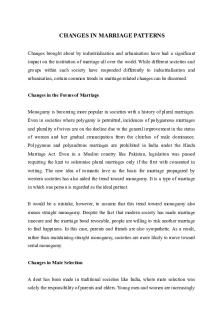Pressure and Volume Changes in the Cardiac Cycle PDF

| Title | Pressure and Volume Changes in the Cardiac Cycle |
|---|---|
| Course | Human Anatomy and Physiology with Lab I |
| Institution | The University of Texas at Dallas |
| Pages | 2 |
| File Size | 55.2 KB |
| File Type | |
| Total Downloads | 2 |
| Total Views | 152 |
Summary
Pressure and Volume Changes in the Cardiac Cycle...
Description
Pressure and Volume Changes in the Cardiac Cycle Figure 20–17 plots the pressure and volume changes during the cardiac cycle. It also shows an ECG for the cardiac cycle. The circled numbers in the figure correspond to numbered paragraphs in the text. The figure shows pressure and volume within the left atrium and left ventricle, but our discussion applies to both sides of the heart. Although pressures are lower in the right atrium and right ventricle, both sides of the heart contract at the same time, and they eject equal volumes of blood. Atrial Systole In atrial systole: 1 Atrial contraction begins. At the start of atrial systole, the ventricles are already lled to about 70 percent of their normal capacity, due to passive blood ow during the end of the previous cardiac cycle. 2 Atria eject blood into the ventricles. As the atria contract, rising atrial pressures provide the remaining 30 percent by pushing blood into the ventricles through the open right and left AV valves. Atrial systole essentially “tops off” the ventricles. Over this period, blood cannot ow into the atria from the veins because atrial pressure exceeds venous pressure. Yet there is very little backow into the veins, even though the connections with the venous system lack valves. The reason is that blood takes the path of least resistance. Resistance to blood ow through the wide opening between the atria and ventricles is less than that through the smaller, angled openings of the large veins. At the end of atrial systole, each ventricle contains the maximum amount of blood that it will hold in this cardiac cycle. That quantity is called the end-diastolic volume (EDV). In an adult who is standing at rest, the end-diastolic volume is typically about 130 mL (about 4.4 oz). Ventricular Systole and Atrial Diastole In ventricular systole: 3 Atrial systole ends; AV valves close. As atrial systole ends, ventricular systole begins. As the pressures in the ventricles rise above those in the atria, the AV valves are pushed closed. 4 Isovolumetric ventricular contraction occurs. During the early stage of ventricular systole, the ventricles are contracting, but blood ow has yet to occur. Ventricular pressures are not yet high enough to force open the semilunar valves and push blood into the pulmonary or aortic trunk. Over this period, the ventricles contract isometrically; in other words, they generate tension and pressures rise inside them, but blood does not ow out. The ventricles are in isovolumetric contraction: All the heart valves are closed, the volumes of the ventricles do not change, and ventricular pressures are rising. 5 Ventricular ejection occurs. Once pressure in the ventricles exceeds that in the arterial trunks, the semilunar valves are pushed open and blood ows into the pulmonary and aortic trunks. This point marks the beginning of ventricular ejection. The ventricles now contract isotonically: The muscle cells shorten, and tension production remains relatively constant. (To review isotonic versus isometric contractions, look back at Figure 10–18, p. 317.) During ventricular ejection, each ventricle ejects 70–80 mL of blood, the stroke volume (SV) of the heart. The stroke volume
at rest is roughly 60 percent of the end-diastolic volume. After reaching a peak, ventricular pressures gradually decline near the end of ventricular systole. Figure 20–17 shows values for the left ventricle and aorta. The right ventricle also undergoes periods of isovolumetric contraction and ventricular ejection. 6 Semilunar valves close. As the end of ventricular systole approaches, ventricular pressures fall rapidly. Blood in the aorta and pulmonary trunk now starts to ow back toward the ventricles, and this movement closes the semilunar valves. As the backow begins, pressure decreases in the aorta. When the semilunar valves close, pressure rises again as the elastic arterial walls recoil. This small, temporary rise produces a valley in the aortic pressure tracing, called a dicrotic (dı . -KROT-ik; dikrotos, double beating) notch....
Similar Free PDFs

The cardiac cycle - anatomy
- 1 Pages

The Cardiac Cycle Notes
- 4 Pages

Cardiac Cycle worksheet revised
- 8 Pages

Biology-Cardiac-Cycle
- 2 Pages

04 - Cardiac Cycle
- 5 Pages

Flow chart of the cardiac cycle
- 1 Pages

Changes in the land
- 2 Pages

Ch. 20 Animation Cardiac Cycle
- 2 Pages

Changes in the land 1
- 24 Pages

Changes IN Marriage Patterns
- 4 Pages
Popular Institutions
- Tinajero National High School - Annex
- Politeknik Caltex Riau
- Yokohama City University
- SGT University
- University of Al-Qadisiyah
- Divine Word College of Vigan
- Techniek College Rotterdam
- Universidade de Santiago
- Universiti Teknologi MARA Cawangan Johor Kampus Pasir Gudang
- Poltekkes Kemenkes Yogyakarta
- Baguio City National High School
- Colegio san marcos
- preparatoria uno
- Centro de Bachillerato Tecnológico Industrial y de Servicios No. 107
- Dalian Maritime University
- Quang Trung Secondary School
- Colegio Tecnológico en Informática
- Corporación Regional de Educación Superior
- Grupo CEDVA
- Dar Al Uloom University
- Centro de Estudios Preuniversitarios de la Universidad Nacional de Ingeniería
- 上智大学
- Aakash International School, Nuna Majara
- San Felipe Neri Catholic School
- Kang Chiao International School - New Taipei City
- Misamis Occidental National High School
- Institución Educativa Escuela Normal Juan Ladrilleros
- Kolehiyo ng Pantukan
- Batanes State College
- Instituto Continental
- Sekolah Menengah Kejuruan Kesehatan Kaltara (Tarakan)
- Colegio de La Inmaculada Concepcion - Cebu





